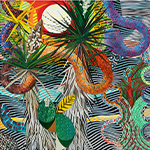Returning to Santa Monica Airport from February 29 to March 3, 2024, the fifth edition of Frieze Los Angeles is supported by global lead partner Deutsche Bank, continuing over twenty years of a shared commitment to artistic excellence.
Steered by Christine Messineo, Frieze’s Director of Americas, and housed in a bespoke structure designed by Kulapat Yantrasast’s architectural studio WHY, Frieze Los Angeles 2024 will see a reconfigured site plan across the airport campus that expands the signature Frieze tent and reimagines the outdoor space as a central gathering point. This year’s fair will bring together over 95 exhibitors from 21 countries, all under one roof, with nearly 50 percent of the fair dedicated to galleries operating in the Greater Los Angeles region. The much-celebrated Focus section of the fair will be overseen for the first time by Essence Harden (Visual Arts Curator, California African American Museum) and explore the idea of ecology to highlight a diverse selection of US galleries that have been in operation for 12 years or less.
Christine Messineo (Director of Americas, Frieze) said: ‘Frieze Los Angeles 2024 will be a destination for an international audience, coming together to celebrate the continued growth of the Los Angeles art scene. Both visitors and exhibitors will benefit from our expanded footprint, centralized layout and redesigned exterior spaces. We look forward to welcoming galleries from around the globe (including leading art spaces across Asia, Africa, Europe, and South America), from Korea to Mexico, Japan to Germany, alongside a strong core of exhibitors from across California, to provide an unparalleled snapshot of today’s most compelling artists and galleries.’
Kulapat Yantrasast stated: ‘After several years in this creative city, Frieze Los Angeles has become an anchor for all creative minds. The layout for 2024 is streamlined and efficient but designed with good sight lines and discoveries at every corner. Inside is a focused art experience with uplifting filtered natural light while the outside courtyard is full of art and cultural activities for friends to linger and connect.’ Describing the exterior space, Mark Thomann (Director, WILDING X WHY) added, ‘Amidst the vibrant installations and pop-ups, imagine a welcoming sanctuary centered on food, culture, and community as a prelude to the Frieze LA experience.’
Frieze Los Angeles will also welcome the return of the critically acclaimed program of site-specific artworks situated throughout the Santa Monica Airport airfield, with public activations across the athletic fields and sculpture exhibited throughout the community park. Additionally, the fair will continue to provide a platform for local non-profits and see the latest installments of two longstanding initiatives: the Deutsche Bank Frieze Los Angeles Film Award, now in its fifth year, and the Frieze Impact Prize — a collaboration between Frieze and Endeavor Impact in partnership with the Center for Art & Advocacy and its fellowship program, Right of Return.
WORLD LEADING GALLERIES
The fair’s list of exhibiting galleries features a concentrated group of Los Angeles-based spaces including Blum, The Box, Château Shatto, François Ghebaly, David Kordansky Gallery, L.A. Louver, Night Gallery, Nonaka-Hill, Regen Projects, Parrasch Heijnen, Hannah Hoffman, Marc Selwyn Fine Art and VSF/ Various Small Fires. Parker Gallery and Anat Ebgi, both hailing from Los Angeles and having previously participated in the Focus section, have this year graduated to the fair’s main section. Major international exhibitors, many of which have opened locations in Los Angeles, include 303 Gallery, Canada, Clearing, Pilar Corrias, Dastan Gallery, Gagosian, Gladstone, Hauser & Wirth, Galerie Max Hetzler, Xavier Hufkens, Gallery Hyundai, Jenkins Johnson Gallery, Lisson Gallery, Mendes Wood DM, OMR, Ortuzar Projects, Pace Gallery, Maureen Paley, Proyectos Monclova, Sprüth Magers, Welancora Gallery, White Cube and David Zwirner.
Frieze Los Angeles 2024 will see 14 first-time participants, with a strong representation from Asia including Shanghai-based galleries Bank and MadeIn Gallery as well as Silverlens, hailing from Manila. Further new participants include Kasmin, Petzel and Rachel Uffner Gallery.
FOCUS, A PLATFORM FOR YOUNG US GALLERIES
Focus, the celebrated section for young US galleries, is curated for the first time by Essence Harden (Visual Arts Curator and Program Manager, California African American Museum). An anchor of Frieze’s contemporary fairs, Focus provides a valuable platform for emerging and underrepresented voices. Supported by Stone Island, whose grants promote participation in Focus alongside Frieze’s existing subsidies, the section features 12 galleries. Each showcases a solo presentation that considers ecologies as a vibrant framework for art making.
Essence Harden (Visual Arts Curator and Program Manager, California African American Museum) said: ‘I’m honored to curate the 2024 Focus section for the LA fair and to work alongside Christine Messineo. I was deeply interested in the possibility of stretching the term ecology to include position, geography, material and theoretical concerns within art making. The presentations chosen for this year’s Focus section reflect that winding impulse, highlighting a series of dynamic emerging galleries and artists.’
This year, the Focus section sees eight galleries making their Frieze Los Angeles debut: Babst Gallery, Matthew Brown, Dominique Gallery, Quinn Harrelson, Lyles & King, Micki Meng, Shulamit Nazarian and pt. 2 Gallery; alongside returning exhibitors Make Room, Ochi, Sow & Tailor and Hannah Traore Gallery.
MAJOR INSTITUTIONAL EXHIBITIONS THROUGHOUT FRIEZE WEEK
In celebration of Frieze Week, the city’s preeminent museums including Getty, The Museum of Contemporary Art, The Broad, Hammer Museum, LACMA, ICA LA and Academy Museum of Motion Pictures will host a series of dedicated events and activations, offering local and international visitors alike with opportunity to discover the world-class collections found in Los Angeles.
Press release from Frieze
Image: Luiz Zerbini. Serpentário. 2023. Acrylic on canvas. 160 x 160 cm. Photography by Pat Kilgore. Image courtesy the artist and Stephen Friedman Gallery, London and New York. © Luiz Zerbini



